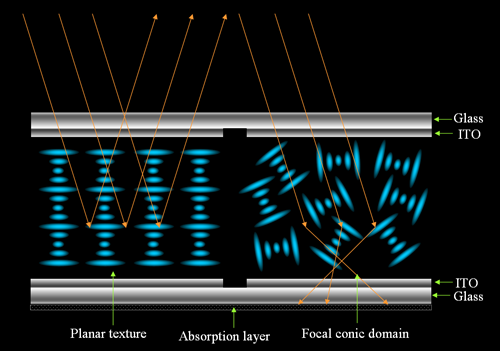ˇˇ[Cholesteric Liquid
Crystal Reflective mode]
Cholesteric liquid crystals (ChLC), also known as chiral nematic LC, either
consist of chiral nematic LC or nematic LC with addition of chiral
agent. The ChLC display utilizes the brag reflection as the reflection state,
and the focal conic domain as the non-reflection state.

Figure 1. A simple structure of
Cholesteric Liquid Crystal Display.
When the helix of the twist aligns along the normal of the substrate, a
planar or Grandjean texture is obtained. This director configuration has the
property of reflecting a component of the incoming light. When the component of
the circularly polarized light which has the same sense of the helical twist, it
will be reflected, and the other opposite component is transmitted. The center
wavelength ¦Ë0 of the reflected light can be described:

where the band width of reflection is:

A typical reflectivity versus wavelength for a planar cholesteric cell is shown
below:

Figure 2. Reflection band in a
planar cholesteric cell.
When a voltage is applied on the planar texture, a focal
conic domain configuration is obtained. In this state, the reflection is mostly
eliminated, and light can pass through the cell, and absorbed if an absorption
layer is coated on the exit. Both the planar and focal conic
domain are stable states, no field is required to maintain it, therefore bistability can be achieved.
ChLC display is now widely used from reflective display,
signage to electronic paper, due to its virtually no power consumption, sun-readable and excellent
viewing angles advantages. Many modifications were added to improvement its performance,
like polymer stabilized cholesteric texture, full-color ChLC LCD etc.
Further Readings
and References:
Deng-Ke Yang, Xiao-Yang Huang, and Yang-Ming
Zhu, "Bistable Cholesteric Reflective Displays: Materials and Drive
Schemes", Annu. Rev. Mater. Sci. 27:117¨C46, (1997)
ˇˇ